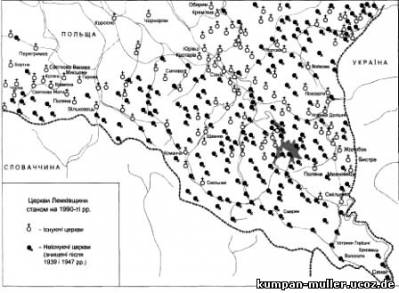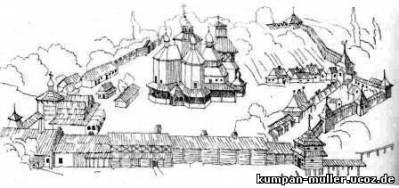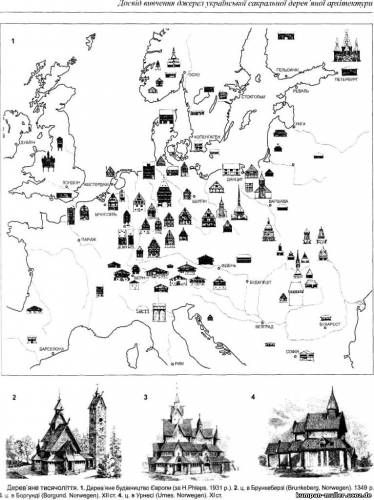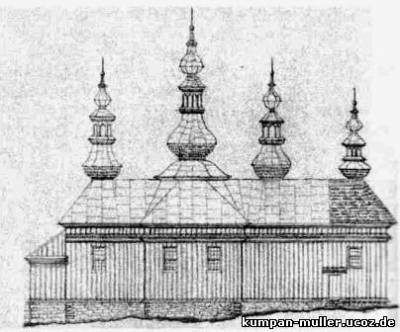Alexander Vasiljev-Muller Dr.econ(PhD)
Publisher
| Главная » Статьи » Litawa-Gothia-Odessa//Литва-Готия-Дженестра /Pavel Antonovich Vasiljev & Pelagej Danilovna Polansky |
Churches-Violins/Part II/ Sacral architecture of Central Europe : historical hypotheses /Dr. (PhD)-eng. Alexander Vasiljev-Muller
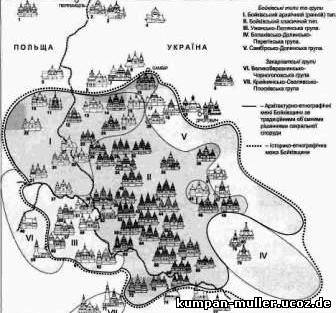 Fig. 9. From Monograph of Ya. Taras Types and groups of churches on Bojkov’s Land after by volume decisions: 1.Patkova Ruska, Poland, in 1732yr. 2. Torki, in I half ХУІІ of century 3. Dusivci, in 1641yr. 4. Pidliski, 1665yr. 5. Liskovate, Poland, in 1832yr. 6. Old Salt. Church of St. Patnicy, XVII century. 7. Old Salt. Church of Voskresenie Dominical, XVII century. 8. Morozovichi, XVII century. 9. Tyniv, in 1718yr. 10. Rivne (Rovno), Poland, 1780yr. 11. Goshiv, in 1858yr. 12. Mshanec, 1762yr.13. Mala Linina, in 1742yr. 14. Busovysjko, 1780yr. 15. Zvir, in 1792yr. 16. Chukva, in 1854yr. 17. Lopushna, XVII century. 18. Naguevychi, in 1801yr. 19. Drogobych, Church Vozdvizgenia of Honest Cross, in 1613yr. 20. Drogobych, Church St. Ura, end ХУ- begin XVI century. 21.Smerek, Poland, began ХІХ ct. 22. Hrevtj, Poland in 1787yr. 23. Gukotyn, in 1876yr. 24.Topilnycia, Church of Uspenia St. God’s Mather, in 1730yr. 25. Nedilnia, in 1779yr. 26. Pidbuz, 1828yr. 27. Boberka, Gorishi of the XVIII century. 28.Wolfish, Church Introduction of St. God’s Mather, in 1680yr. 29. Yavora Gorishnia, 1882yr. 30. Іsai, in 1663yr. 31. Stuposiany, in 1787yr. 32. Boberka, 1723yr. 33.Wolfish, Church Christmas of St. God’s Mather, in 1890yr. 34. Turka, Church St. Nicolay, in 1739yr. 35. Long Pidbuzke, 1723yr. 36.Оrove, in 1867yr. 37. Volosa, Poland, 1742 yr. 38. Botelka Verhnia, ХУШ of century. 39..Yabluniv, in 1838yr. 40. Ilnik, in 1860yr. 41. Verhne Siniovidne, in 1790yr. 42. Rosgoa, 1882yr. 43. Roztoka Verhne, in 1862yr. 44. Tysovec, in 1863yr. 45. Skole, XVII century. 46. Kamianka, 1872yr. 47. Truhaniv, in 1830yr. 48. Polan, in 1850yr. 49. Salt, 1703, XIX century. 50. Volosianka, XVIII century. 51. Uzgokк, in 1745yr. 52. Sianky, in 1831yr. 53. Vysocke Nizgne, 1814yr. 54. Red (Krasne) 1850yr. 55. Matkiv, in 1838yr. 56.Oriavchik, I half ХІХ of century. 57.Tower (Vyshka), 1700, XVIII of century. 58. Suhoj (Dry), in 1700yr, in 1769yr. 59.Dark-haired (Chornogolovyj), XVII of century, 1794yr. 60. Kostryno, 1645yr., 1761yr. 61. Gusnyj, 1655yr. 62. Cross (Perehresnyj), in 1641yr. 63. Kryvka, XVII century. 64. Mohnate (Shaggy), begin ХІХ st. 65. Kalne, 1823yr. 66.Tuholka, in 1845yr. 67. Hitar, in 1860yr. 68. Oporec, in 1844yr. 69. Verhnia Rozganka, in 1804yr. 70. Svaliava-bystryj, in 1588yr, in 1759yr. 71. Kans; in 1792yr. 72. Volovec, XVIII century. 73. Takamash, XVII century. 74. Guklyvyj, begin ХУІІІct. 75. Verhnij Studenyj (Overhead very Cold), XIX century, in 1804yr. 76. Rekity, 1759yr. 77. Sinevirska Polania, 1817yr. 78. Sloboda Bolehovskaya, in 1700yr. 79. Lila, in 1720yr, in 1901yr. 80. Roztoki, in 1832yr.
It is necessary sincerely thanks full to Yaroslav Mykhajlovichu Tarasu for really scientific approach. He, not coming from our conception, honestly reflected distribution of main for Carpathians sacral schools on a chart, but this chart confirms our conclusions in relation to distribution of thorough sacral knowledge, namely in Gucul’s Land, Bojkov’s Land, Lemkiv’s Land. And although farther Ya.М.Taras points a chart on which shows influence of snow layer on the construction of churches on Bojkov’s Land, but this chart yet more confirms our conclusion in relation to the features of construction of sacral building in Carpathians (Look Picture 10).
 Picture 10 Actual dependence of construction of churches on understanding them deeply of prayer setting is a new look to the chart of Ya.М.Taras.
Will consider the types of churches of Lemkiv’s Land, that most near to Bojkov’s Land.
 Picture 11. Lemkiv’s Church of Sent Dmytro. Roztoka Large. in 1819yr.
 Picture 12. Lemkiv’s Church of Sent Mykhajlo. Loseє. 1826 yr.
Analysing principles of construction 16 churches of Lemkiv’s Land you can clearly see, that all builders saved basic principles of building of bath-houses! Really, it is needed it was to bring up masters in inviolability of building proportions, speaking about church canons. Because all that is now perceived as traditional elements for the decoration of church building, carried the deeper rational loading in actual fact .
Therefore maintenance of proportions was really a necessity for the sake of achievement planned of Europeans of effect spiritual leaders. That deep and invincible result which humanity purposefully arrives at already 2000 years.
It we see also at building of bell towers, especially, on Lemkiv’s Land.
3. Masters of creation of magic of prayer symphonies - "Stradivari" of Carpathians is unknown.
Something very deep and large in the simplicity brings together creations of Bojkov’s architects with Roman Basilica "Forum", which without alterations was saved from pre-Christian times and has not a single window, but on a center on a mountain in its there is the round opening on the semi-spheres of ceiling. The grandeur of this building feels each subconsciously, who though on an instant touches at Basil.
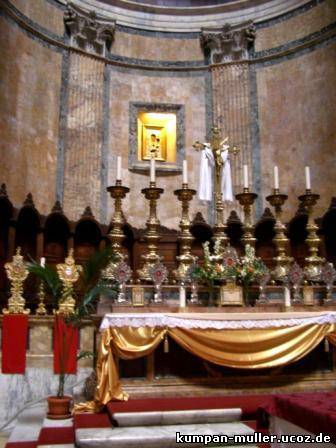 Picture 13. Large simplicity of Forum (Rome, in 2011) is a standard on all next centuries.
And does not cause a surprise, that Raphael found upokoj exactly in Forum.
But why to us that all clearly, when we stand in the center of Forum and see above a head of sky ? To us did not come to the note of builders of Forum, but their project us explaining to is not necessary - we understand him (!). Similarly feel a heart the rightness of builders of the Bojkov’s "steps" to sky. They attained it - prayers of humanity in their building were heard (!). But why were just the same correlations of sizes of building elements attained for a century to Christ and at the beginning of the Christian epoch?! There is sense us to investigate it. It is our way of cognition and sure steps at development of the interesting and foreseen future. Indisputably people one and a half thousand years back had a row of high-efficiency approaches in building of sacral building . They used knowledge of very high level, what of us only begin to seize.
If in the Bojkov’s churches emphasized filling of space of overhead constructions of church by rhythms of prayer texts and as yet unknown to us conformity to law of transformation this saturated of space rhythms in sent began to flow up, then in Lemkiv’s of tradition we see something more substantial. There is scientific thought and engineerings decisions in the constructions of all transitional forms from a overhead constructions of church to the Christ. And these engineerings decisions most strike at consideration of charts of Lemkiv’s bell towers (!).
Yes, considering the charts of bell towers of churches : Saint of Kozmy and Dem'yan, (Vojkova. in 1792) under a 1 number; Sent. Kozmy and Dem'yan (Mylyk, in 1813) under 2 numbers; Sent Dimitria (Snitnycia, in 1755) under 3 numbers; Sent Dimitria (Charne, in 1764) under 4 numbers; Sent Yakiv (Povoroznik, in 1612) under a 5 number, we mark existence of only methods of calculation of correlations of structural elements of bell towers. And these correlations are clearly directed for achievement of effect of concentration of prayers (!), and that is why and calculations have only foundation of correlations.
Picture 14. Bell towers of Churches : 1 St.Kozmy and Dem'yan; 2. St. Kozmy and Dem'yan; 3 Sent Димитрія; 4 Sent Dmitria 5. Sent Yakiv.
Our conclusion is confirmed by the charts of bell towers of churches : Pocrovy of Sent of God’s Mather (Zgdynia. in 1795) under a 6 number; Pocrovy of Sent of God’s Mather (Gyrova, in 1780) is under a 7 number; Sent Dimitria (Schavnyk in 1841) under a 8 number; Sent Dimitria (Roztoka Large. in 1819) under a 9 number; Christmas of The Most Holy God’s Mather (Turnips, in 1801) under a 10 number; Sent Dimitria (Bilcareva, in 1760) under a 11 number; Sent Kozmy and Dem'yan (Tylych, in 1743) under a 12 number; Sent Luka (Hazel, in 1835) under a 13 number.
There is sense to check up our conclusions. Therefore will consider the row of bell towers of Lemkiv’s churches yet, namely: Sent Paraskevy; Sent Kozmy and Dem'yan; Sent Ivan Bogoslowa; Sent Dimitria; in the village Bartne; Sent Nicholay; Sent Kozmy and Dem'yan; Sent Mykhajlo; Sent Kozmy and Dem'yan. All architects of bell towers did not give up a canon which presumably all 2000 years. Specialists must study and investigate high accordions and resonations effects. But by not only physicists but also art critics, which must take into account not only the breed of wood, which these bell towers were built from, but also thickness of boards, corners which they were fastened under, and main, all the thickness of elements from wood; because exactly their vibrations created the " violins orchestra" of general prayer and ringing. It it is possible to learn and to understand our highly skilled ancestors (!) the same.
Sizes, correlations, were studied, but not harmonious "symphony of prayer" in combination with the church ringing and acoustics of dome of Church and bell Tower from the different breeds of wood. All of it needs complex research and we will be staggered by a that picture which will be opened. The so much high-tech (speaking a modern language) were used, that a research group must consist of specialists of fifteen directions, beginning from acoustic physics, quantum physics and radio physic, concluding masters of bow instruments and specialists on bio-location. There will be work all of them, and all of them will have the opportunity to deepen understanding of processes which take place at socializing of Christian society with higher forces. It is possible much to pull out questions which need to be investigated, but indisputable is that investigating is necessary all processes which take place in church building and after her limits in the distance from a few meters to ten of kilometers (meaning the layer of air above church building) during all liturgical service. Indexes needs to be collected from the beginning calculating on the complex study of all fixed phenomena. Then we will understand all high-technological of Lemkiv’s of sacral architecture, its scientifically is the symphonic sounding of general prayer of Christian society in Church, built from traditional for Carpathians wood, - buka and oak. That personal beauty which prayer will arrive at exactly in these Churches (they can be examined, as the personal violins for prayer), which will be complemented by the age-old ringing (possibly born-again for to age-old technologies of production), probably will be found nowhere in the world. Because such comprehensive intellectual basis did not create humanity nowhere, except for the region of Carpathians. And it is our not supposition, but already the scientifically confirmed fact.
Thus, it is possible to do one basic conclusion, that those knowledge which was laid in work of productive constructions what of us saw on Sokilskiy’s Mountains, were used for development of Christian temples, including their bell towers, when ringing connected for achievement of the claimed purpose .
4. Influence of Churches-"Violins" which created for the of "prayer symphonies of Carpathians" on the sacral culture of Eastern and Central Europe.
Clearly, that not we the first turned such passionate attention on wooden Churches -"Violin". Graf A. Uvarov considered yet, that the "churches of Galychina had served as standards both for the church of Sent Illia in Kyiv and for all other Christian temples which could exist on to Russia to the final acceptance of the Christian faith" [5], and it was said in 1876 yr. And almost at the same time (in 1882) the Galychin’s Graf V. Didushyckiy paid attention to architecture of Carpathians : "Frivolously we go by those wooden building, seeing work of the forgotten peasant carpenters in them, and read with kind regards about wooden architectural works of Sweden and Norway, China and Japan, does not see that have at a hand our churches more interesting it can and the best from those oversea things (bold type is my - A. V. - M.; and a project was not carpenters !)"[7]. Through 50 years the Czech researcher Florian Zapletal underlined in 1923 years, that wooden churches of Carpathians can be "glory, pride and gladness of every Nation"[6]. But nobody, then did not see that not possibly to us today not to see in an epoch the almost comprehensive use of peaceful laser (from treatment of eyes to the projections in sky during grandiose shows), special acoustic effects and creation of effect of presence for thousands of kilometers from the center of events.
And that most strikes is the amount of these building which on Gucul’s Land, Bojkov’s Land and Lemkiv’s Land was counted to 2500 (!). And it on the two-bit/pl enough of population ! B. Yanush marked, that at the beginning of the XX century 2345 sights of church architecture were counted [8]. Yaroslav Taras points a very interesting map on which operating and destroyed of Churches -"Violin" are marked on Lemkiv’s Land by the state on 1990 (see. Picture 32).
Churches -"Violins" were it is destroyed very much really. And why ? That already is not it needed to fight for maintenance of humanity ?! That we already able to resist to all calls of Universe ? Who so could unwisely belonged to possibility of existence of man on Earth? What need it was to be the underdeveloped leader, to begin a self-destruction !
Interestingly, almost nobody could go quietly by this phenomenon of victory of mind of humanity above all threats and calls modern
and future.
Picture 32. Churches of Lemkiv’s Land by the state on 1990th yr. For Ya. Taras [4].
Brussels’ architect Dhuieque, was chairman of Belgian society of architects, is so known writes: "Some of this timber-works [in architecture of Church.- Ya.Т.] with high roofs really large "pace". I really with a miracle found for them forms which will meet in the same proportions in Flemish architecture of the XVII century. Whether that simple case or consequence of general east influence : here that it would be interestingly to light" [up 4]. Professor Ecole du of Genie Civil [Institute of civil engineers in Genry.- Ya.Т.] Cloquet writes: "For me this [wooden Church.- Ya.Т.] real Discovery. What intensive civilization and what permanent exchange of ideas with the West and by you [Ukrainian - Ya.Т.] took place in ХІП-ХІХ centuries! (bold type is my - A. V. - М.; but not only in ХІІІ-ХІХ of century, and far before !) [4].
Really, considerably before scientific achievements of Ghetto/Dakki-Ukrainians in Carpathians influenced on sacral architecture of all Europe. Possibly better than all foreigners Russian V. Kelsiev spoke out, traveling on Galychina in 1866-1867 yryr.: "Among all to the surprise of dignities of Peremishlia, none did such impression on me, as little Church Christmas of God’s Mather on Bolonju... It is an old church (1655 yr. had built.) which soon will be taken apart, because near its put new, lithoidal, such interesting and such valuable under an archaeological review, that if I had facilities for this purpose, then would buy in its at a local clergy and would put its in Moscow or Petersburg, on to the yard of some museum, under a glass dome"( bold type is my - A. V. В. - М.)[4].
Really, it was why struck . You only will look on so-called many zalomny Bojkov’s Churches -"Violin" from a middle. What high-quality engineerings decisions, to "knock until someone answers sky-high"! What perfection ! These is decisions possibly only to lose, and reach to them by the gradual evolutional selection of the best, almost not possibly and for a millennium.
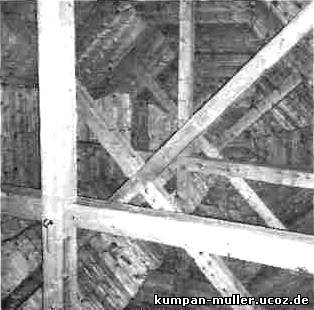 Picture 33. Cross beams (griadovi crosses) in many zalomny Bojkov’s churches. On the left, Church-"Violin" of Sent Mykola. Kryvka. XVIІІ of century ;
It is necessary to mark that in Bojkov’s churches, where the greatest tops, cross beams or svoloky, belonged on a few levels. In four levels put svoloky are in the church of Zislanie of Saint Spirit, vil Nizne Vysocke (in 1814)[9]; in the church of Mykola, vil. Krivka (began XVIII century)[10]; in the church of Mykhajlo, vil. Rosohach (in 1882)[11]. Exactly on it an architect Yaroslav Taras pays attention [4]. In the monograph Yaroslav Taras underlines that in old churches, such as in vil. Radruzg (XVII century)[12], Potelich (first half XVI century)[13], where is one zalom only, "the special spatial construction from staples-beams, which restrained the onslaught of wind was done ( bold type is my - A. V.-М.)" [4].
So all, zaloms in Bojkov’s Churches-"Violins" are only in an order to resist to wind ? And in general, how is such sublimity of Churches-"Violins" and perfection of engineerings decisions explained by architects ? разрушающую It is possible to accede to Ukrainian an architect Yaroslav Mykolaevichem Taras and with his reference on Vicenu in a next utterance: "On counts І. Viceny, in trees pressure of wind on a barrel in 15 times less than, than on a crown. Multi-stage tops with the belts of inflexibility, center of composition was provided firmness to church building even at dangerous winds as cyclones. For reliability, that dicking of tops of church was not during winds, national masters put svoloky yet, griadovi crosses, cross beams which, next to a basic function restrained internal destroying force, also clamped astride and prevented their shaking .(bold type is my - A. V.-М.)"[4]. But somehow quite such utterance is unconvincingly perceived: "Watching operating of wind on separate trees and forest arrays showed that local ecotypes (trees), forms with pectinate and by dashkovidnou crowns more proof against wind-fallen trees. It is noticed also, that a step’s form of tent is better adjusted to the action of wind, and to precipitations. The natural selection of proof forms against wind-fallen trees folk masters applied in sacral building. Today he became basis of defence of the forests from them. Churches with many zalomni tops on Bojkov’s began to be built in the XVIII-XIX century, time of their distribution coincides in course of time mass elimination and replacement of the maternal forests (spruce-beech beechen-oak) on spruce.( bold type is my – A. V.-М.)" [4].
Somehow unconvincingly… Really, to attain a height 17-20 meters of Churches-"Violins" on Gucul’s Land, Bojkov’s Land and Lemkiv’s Land did masters use a natural selection and step’s form of many zalomhi is astride related only to the wind loading and mass elimination and replacement of the maternal forests (spruce-beech beechen-oak) on spruce?
Does not associate something. How many does it need it was to time, that by a natural selection to reach sacral building to such perfect construction? Presumably, almost so much, how many it is needed it would be to be perfected to the monkey, to become a man. Fact of existence of thousands of Churches-"Violins" in Carpathians it is impossible to consider introduced by some unindigenous tradition. Only deeply clear and the deeply perceived purpose could urge on people on such high service, when on small territory the only are created in a deep project, but the different after methods uses of high knowledge, architectural styles. Styles, which not adopted, but which adopted and, will adopt presumably. First of all, it is Bojkov’s school (see. Picture 34), then Gucul’s school (see. Picture 35) and Lemkiv’s school (see. Picture 36).
Picture 34. Bojkov’s school which has parallels with pre-christian Forum (Rome, 2011).
Picture 35. Gucul’s school which really perceived influence of pre-christian Forum (Rome, 2011) in more depth.
Picture 36. Lemkiv’s school which undertook a substantial step in sacral architecture, going out its direct setting.
All other schools which distinguished architects in a that or other measure absorb for itself elements these three schools. And than nearer to Carpathians, that these elements show up better. Especially it perceptibly in the standards of the so-called schools : Opilskaya, PeredCarpathian-Podnestrivskaya and Volhynia (look full text Fig.38-40 ).
Already in ZaCarpathian (Fig 37) we see that begin to walk away from canons, and on Bukovyna (Fig. 38) this departure especially strikes. How here not to remember the fight of Ukrainians-Ghetto/Dakki after Bukovynu – Trajan’s Dakkia after its loss in 105 in a fight against Rome, which was populated by a population from Roman Empire, which and ideas then quite a bit about Large Laws of Universe and immortality of the soul.
Picture 37. ZaCarpathian school.
Picture 38. Bukovyna school.
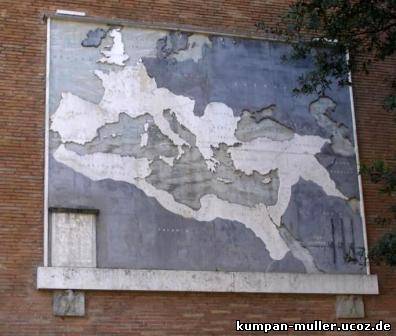 Picture 39. Map of Roman Empire after fascination of Getto-Dakki (after 105yr.) on a defensive wall in Rome (from Coliseum to Trajan of Column; 2011).
Other we see in the so-called schools: to Podilskiy school, where influence is in opinion of architects of East and the West (look full text Fig. 44); to NadDniprianskiy school, so-called Kyiv’s and Middle Dneprianskaya (look full text Fig. 45); To Poltava school (look full text Fig. 46); to Chernigivskiy (Chernigov’s-Siverskaya) school (look full text Fig. 47); Slobozganskiy (Western, Central /Ohtyrskaya/, Limanskaya, East) schools (look full text Fig. 48).
It is impossible not to see, especially, at Poltava school (look full text Fig. 46), Chernigivskiy to school (look full text Fig. 47) and Slobozganskiy school (look full text Fig. 48) of combination of approaches of Lemkiv’s of school in the structure of tops with Bojkov’s tradition of creation of enormous volumes, sent up. And this combination probably took place due to the high understanding of intercommunications of human history with events in Universe, which came on earth of Ghetto/Dakki-Ukrainian in 271 with the German warriors which was invited for a fight against Rome. They created a state autonomy on the walks of life of Eastern Europe, so-called. Knight's Order "Gothia-Zaporozskaya Sich" which existed to 1775 yr., traditions of which then not once regenerated: in Cossack’s Azov Army (1828-1866), in activity of metallurgical combines "Russian Providans" and "Nikopol’s Plant" (1898-1920); and from 30th of ХХ of century in Mariupol’s Steel Plant "Azov Steel", Mariupol’s Steel Plant named of Illicha, IC "AzovMash" and the Azov’s Marine Steamship line (AMSL) which was complemented in the years of independence of Ukraine by activity of FEZ "Azov" and creation of multi-field joint-stock association of "SP named of Illicha" (1994-2011 yryr.).
Picture 40. Mizgirskiy monastery near-by Kyiv. For picture 1651yr. Cathedral Spasa. 1606yr. A founder was Zaporizhzhya Sich.
As Zaporizhzhya Sich/Gothia influenced on building of sacral building it is possible to see on a picture 40, where it is represented Mizgirskiy monastery, made to order leaders of East Knight's (Cossack) Order. It is possible confidently to assert that this order influenced on all five architectural schools (Podilskiy, where influence of East was only set, NadDniprianskiy, so-called Kyiv, Poltava, Chernigivskiy and Slobozganskiy) transferred by us.
But most interestingly to consider, even retrospectively, influence of high level of spiritually-natural knowledge of Ghetto/Dakkiv-Ukrainian and Cossack’s/Goths on sacral traditions on East and the West. Better Europeans nobody will say. Because, unlike an architect Yaroslav Taras, we will not talk about the Western sources of Ukrainian sacral architecture, but will talk about borrowing of ideas of Ukrainian sacral architecture by masters of the West. It we see on a picture 41: building of tops in sacral building becomes more distant from the project of creators of the first sacral building in Carpathians on the measure of remoteness from Bojkov’s Land and Lemkiv’s Land.
Becomes clear us, why in Poland meet such perfect building of Lemkiv’s Church-"Violin" (Look full text Fig. 51), which not only not what does not differ from building of Lemkiv’s Churches-"Violins" within the limits of modern territory of Ukraine but also induces us to remember all historical tragedies with migration of Ukrainians-Getto/Dakkiv from their historical region settling apart to the areas, which were by then within the limits of Ukraine. So much it was these migrations from instantaneous interests of geopolitics, then only sacral building about it remind the descendants of their really historically-native earth, where Great People prayed to which they have an ethnic relation.
Picture 41. Influence of innovative decisions of Churches-"Violins" on sacral architecture of Western Europe [4].
The same, almost Lemkiv’s Church-"Violin" see in Komanchi (Poland), which was also drawn by A. Varyvoda, but in 1800-1803 yryr. (Fig. 42).
Picture 42. Churches-"Violin" of Pocrovy Sent God’s Mather. Komanchi. Poland 1800-1803yryr. Pic. A. Varibody [4].
If you understood in the article all of hypothesis oh tendencies in sacral building, learned a picture 50 and familiarized with pictures from 34 to 42 (look full text Fig. 35-52), then it is possible to do such small experiment.
Experiment in Third Part Источник: http://azov-academy.ucoz.org/publ | |
Категория: Litawa-Gothia-Odessa//Литва-Готия-Дженестра /Pavel Antonovich Vasiljev & Pelagej Danilovna Polansky | Добавил: Vasiljev (2011-07-25)
| Автор: Alexander Vasiljev-Muller  
| |
| Просмотров: 3915 | Теги: | Рейтинг: 5.0/1 | |
| Всего комментариев: 0 | |
Приветствую Вас Гость
Форма входа |
|---|
Категории раздела | |||||||
|---|---|---|---|---|---|---|---|
|
Поиск |
|---|
Наш опрос |
|---|
Статистика |
|---|
Онлайн всего: 1 Гостей: 1 Пользователей: 0 |
Друзья сайта |
|---|
|
|

